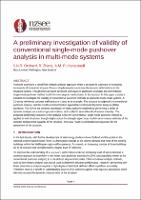| dc.contributor.author | Zhang, Ruozi | |
| dc.contributor.author | Orchard, Stuart | |
| dc.contributor.author | Puthanpurayil, Arun M. | |
| dc.date.accessioned | 2023-02-21T01:18:09Z | |
| dc.date.available | 2023-02-21T01:18:09Z | |
| dc.date.issued | 2022-04-27 | |
| dc.identifier.uri | https://repo.nzsee.org.nz/xmlui/handle/nzsee/2469 | |
| dc.description.abstract | Pushover analysis is a simplified inelastic analysis approach where a structure is subjected to increasing increments of monotonic imposed force or displacements to estimate the inelastic deformations in the structural system. Though there are more advanced techniques of pushovers available, the conventional single-mode pushover method is still the most popular method used in the industry. In this paper, a study is initiated to investigate the validity of conventional pushover methods as applied to multi-mode systems. A 12-storey reinforced concrete wall structure is used as an example. The structure is subjected to conventional pushover analysis, and the results are benchmarked against the Incremental Dynamic Analysis (IDA) backbone. The IDA is the dynamic counterpart of static pushover obtained by performing a series of dynamic analyses on a suite of ground motions, each scaled to several levels of seismic intensity. The proposed preliminary outcome of the analysis is that the conventional, single-mode pushover method as applied to wall structures, though might capture the strength aspect may result in an erroneous estimate of the inelastic displacement capacity of the structure. This may result in unintended consequences for the assessment of the structure. | |
| dc.language.iso | en | |
| dc.publisher | New Zealand Society for Earthquake Engineering | |
| dc.relation.ispartofseries | 2022;15 | |
| dc.subject | Advancements in structural and geotechnical design and assessment | |
| dc.title | A preliminary investigation of validity of conventional single-mode pushover analysis in multi-mode systems | |
| dc.type | Article | |

